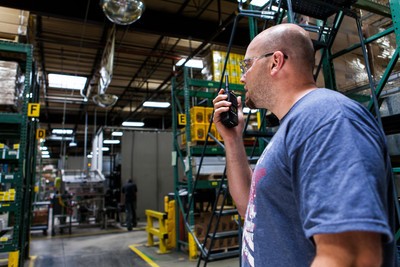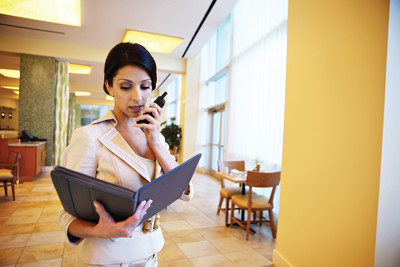Radio: the digital decade
By Bevan Clarke - General Manager, Radio Solutions, Motorola Solutions Australia and New Zealand
Thursday, 13 June, 2013
A seismic shift is taking place in the radio world, shaping the future of how most of us will communicate in the years to come.
While the adoption rate of digital two-way radio in Australia and New Zealand is among the highest globally, analog systems are still dominant worldwide. A recent survey suggests that up to 80% of two-way radio users are still using analog systems, even though many of them are using hybrid digital systems.
Even so, more than 70% of those surveyed stated they were planning to migrate to digital in the next five years, and over half of those within the next two years.
While voice communications remains the number one application for two-way radio - both digital and analog - the drive behind the shift towards digital lies in data applications.
With parallels in the smartphone world, where data applications - or apps - have transformed the humble mobile phone into a portable computer, similar changes are afoot in the radio world.
Ironically, the ubiquity of smartphones has partly become a catalyst for radio’s metamorphosis, mainly because smartphones have begun to overlap, and sometimes supersede, the utility of two-way radio, adding significant cost (and risk) to companies with hundreds of field workers.
In some cases, apps have become mission-critical, making them indispensable to fieldwork. Given the complex, real-time interactions between field personnel and those back at headquarters, radio technology has had to evolve just to keep up with demand.
Two-way radio apps
Two-way radio apps are increasingly being developed to suit specific business needs, as opposed to organisations working around standard apps to make them fit.
There are hundreds of two-way radio software application developers across the Asia-Pacific region alone, focused on developing business-specific applications for public safety, manufacturing, transport and logistics, security, hospitality, construction and mining organisations.
As these apps are being developed, two-way radio handsets are beginning to replace other proprietary devices that were previously used for the sole purpose of performing one or more specialised functions - functions that can now be done by the radio and the app.

The history of two-way radio is a long one; so long in fact that analog radio has reached its innovation ceiling. Everything that can be done with analog radio - which by its very nature can only perform one task at a time - has been done.
But analog radio’s longevity is also its strength: familiarity breeds ubiquity, and two-way radio has become almost as entrenched as a home appliance in many organisations. The transition to digital has taken off, with at least a decade of evolution in digital radio standards such as TETRA and Project 25.
If digital radio is to succeed, it first has to overcome the inertia of analog systems that are practically embedded in the lifeblood of field communications and, on the whole, still perform admirably.
The tipping point
The shift towards digital technology began for entirely different reasons. Digital introduced several advantages over analog systems that made a significant difference in the field.
For example, improved voice quality - and the partial elimination of background noise when converting the human voice to digital signals - had positive implications in noisy environments.
Spectrum efficiency - the ability to use a single digital frequency for multiple voice and data streams - made digital systems far more scalable and introduced additional benefits, such as simultaneous voice and data streams to digital handsets that allow for, among other things, sending and receiving critical information while engaged in a voice call.
Other benefits such as open standards between digital radio systems (allowing for mix-and-match handsets) and higher levels of encryption, critical to companies in the security industry, for example, have each in their own way fuelled the initial migration from analog to digital.
The marriage of apps and mobile phones turned the mobile world on its head almost overnight. Yes, apps were available on mobiles in one form or another long before the iPhone was even conceived. But no device prior to the iPhone made the app the selling point of a phone. From that point onwards, the smartphone market made the steep and rapid leap towards critical mass - a trajectory that shows no signs of abating more than five years later.
Now, a new generation of apps is about to tip the scales for digital two-way radio in the very same way.

Digital killed the analog star
We no longer live in an analog age. A new generation of consumers has been sensitised to data ubiquity - be it text, video, images or even digitised voice, often all at once.
This behaviour is rapidly spilling over into the workplace, with the smartphone revolution the most obvious example. While smartphones have so far had limited utility in remote areas and for mission-critical tasks in the mining industry, for example, the data they can carry is of great importance. If anything, access to rich data in the field is transforming the workplace. New generation digital radio handsets are already adopting smartphone-like functionality - picture messaging, GPS tracking and internet access to name a few.
Let’s take applications being used in the resources sector as examples. Tracking applications using the GPS tracking capabilities of digital radios have been developed that can easily locate the worker the radio is attached to, which assists in compliance with an increased focus on occupational health and safety regulations.
In addition, the two-way radio in a truck can signal whether a truck is speeding or in the wrong area, increasing productivity and efficiency and further ensuring safety.
The biggest challenge to digital radio is not analog radio, especially since many analog networks and devices will, over the next few years, reach the end of their useful life and will cost more to maintain than the cost of replacing them with digital alternatives.
No, the biggest challenge to digital radio is the other digital devices that may make radio - digital or otherwise - redundant.
Mobile networks are nowhere near the point of radio’s maturity, at least not for niche applications and in remote locations. But as mobile technology improves, and its reach extends outward via new-generation wireless and satellite networks, radio will continually have to justify its place.
Thankfully, it’s the tailored business - and mission-specific apps being developed (GPS tracking, visual and audio feedback and location services, among others) - that have already begun to move digital handsets into workers’ hands faster than at any other time in history.
Wireless networks for mine management
Today's fleet management applications form the foundation for a future where driverless...
Wireless networks for mine management
Today's fleet management applications form the foundation for a future where driverless...
Interoperability for Tasmania's emergency services
Tasmanian police, fire and ambulance services can now communicate directly with each other,...




